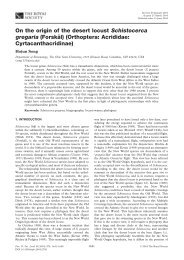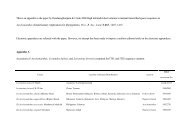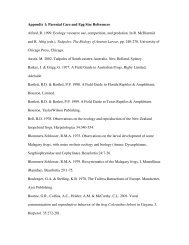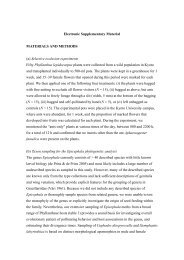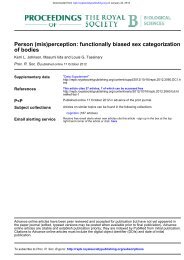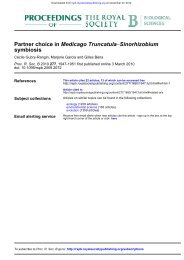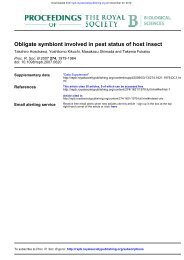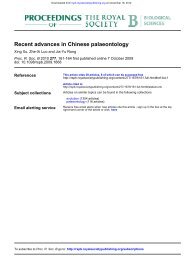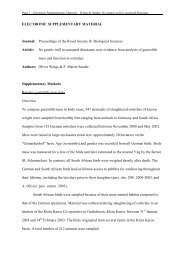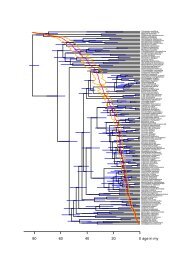A. Table 1. List of species and data - Proceedings of the Royal ...
A. Table 1. List of species and data - Proceedings of the Royal ...
A. Table 1. List of species and data - Proceedings of the Royal ...
Create successful ePaper yourself
Turn your PDF publications into a flip-book with our unique Google optimized e-Paper software.
Psophiidae (<strong>1.</strong>07 ± 0.02, <strong>species</strong> n = 2), <strong>and</strong> Heliornithidae (<strong>1.</strong>15 ± 0.12, <strong>species</strong> n = 2). However,<br />
although <strong>the</strong> Rallidae were considered <strong>the</strong> most basal clade within Gruiformes by Sibley <strong>and</strong><br />
Ahlquist (1990), this conclusion is controversial. On <strong>the</strong> basis <strong>of</strong> a cladistic analysis <strong>of</strong><br />
morphological characters, Livezey (1998) hypo<strong>the</strong>sised that <strong>the</strong> Rallidae are derived within <strong>the</strong><br />
order, <strong>and</strong> that clades with BI < 1 such as Turnicidae (mean BI = 0.99 ± 0.05, <strong>species</strong> n = 7) <strong>and</strong><br />
Otididae (mean BI = 0.91 ± 0.04, <strong>species</strong> n = 10) represent <strong>the</strong> most basal divergences. Indeed, <strong>the</strong><br />
remaining families within this group are consistent with <strong>the</strong> reported trend in that <strong>the</strong>y have BI<br />
values <strong>of</strong> > <strong>1.</strong><br />
Within Sibley <strong>and</strong> Ahlquist's (1990) large order Ciconiiformes, a few anomalous clades are<br />
characterised by BI > 1: Procellariidae (<strong>1.</strong>05 ± 0.07, n = 35), Gaviidae (<strong>1.</strong>25 ± 0.05, n = 6),<br />
Spheniscidae (<strong>1.</strong>37 ± 0.10, n = 18), Sulidae (<strong>1.</strong>02 ± 0.15, n = 14) Anhingidae (<strong>1.</strong>11 ± 0.04, n = 2)<br />
<strong>and</strong> Podcipedidae (<strong>1.</strong>12 ± 0.07, n = 12). The Laridae also exhibit a BI > 1 (<strong>1.</strong>15 ± 0.38, n = 54),<br />
which is explained by <strong>the</strong> inclusion <strong>of</strong> underwater swimmers such as <strong>the</strong> auks <strong>and</strong> guillemots (<strong>the</strong><br />
Alcidae, sensu Wetmore (1960)), that without exception have BI values > <strong>1.</strong><strong>1.</strong> The more aerial<br />
<strong>species</strong> within <strong>the</strong> Laridae (terns <strong>and</strong> gulls) exhibit BI < <strong>1.</strong> Once again BI values <strong>of</strong> < 1 appear to be<br />
primitive for Ciconiiformes: all <strong>of</strong> <strong>the</strong> basal lineages within Ciconiiformes (<strong>the</strong> clades including <strong>the</strong><br />
Falconidae <strong>and</strong> Pteroclidae) have BI's < <strong>1.</strong><br />
BI distribution among <strong>the</strong> phylogeny <strong>of</strong> Cracraft et al (In press) is similar to that found for Sibley<br />
<strong>and</strong> Ahlquist's phylogeny. Paleognaths <strong>and</strong> <strong>the</strong> Galloanserae are characterised by BI > 1, <strong>and</strong> higher<br />
clades by BI < <strong>1.</strong> Clades exhibiting BI > 1 are identical to those discussed above with reference to<br />
<strong>the</strong> hypo<strong>the</strong>sis <strong>of</strong> Sibley <strong>and</strong> Ahlquist (1990), but a lack <strong>of</strong> resolution amongst <strong>the</strong> 'higher' l<strong>and</strong>-bird<br />
clades (a polytomy) precludes a detailed discussion <strong>of</strong> BI distribution across <strong>the</strong> phylogeny.<br />
Although our analyses have demonstrated <strong>the</strong> presence <strong>of</strong> a remarkably stable fit between BI <strong>and</strong><br />
phylogeny, <strong>the</strong>re are a number <strong>of</strong> exceptions to this trend. All <strong>of</strong> <strong>the</strong>se exceptions, however, occur<br />
within clades characterised by mean values <strong>of</strong> <strong>the</strong> BI that do fit within <strong>the</strong> overall trend (i.e., within<br />
a clade that is overall consistent with reported trends). Fur<strong>the</strong>r investigation shows that exceptions<br />
are ei<strong>the</strong>r secondarily flightless (or near flightless) birds that have evolved to use <strong>the</strong>ir wings to<br />
swim underwater, or are taxa that have unusual ecologies (when compared to o<strong>the</strong>r members <strong>of</strong> <strong>the</strong><br />
same clade) (Rayner & Dyke 2002).<br />
Gruson, E. S. 1976 A Checklist <strong>of</strong> <strong>the</strong> Birds <strong>of</strong> <strong>the</strong> World. London: Collins.



